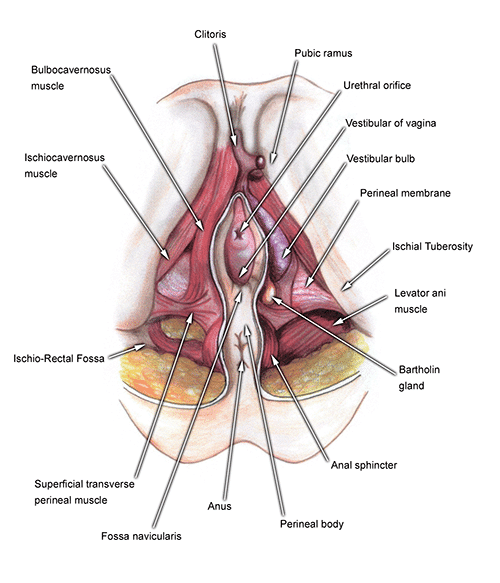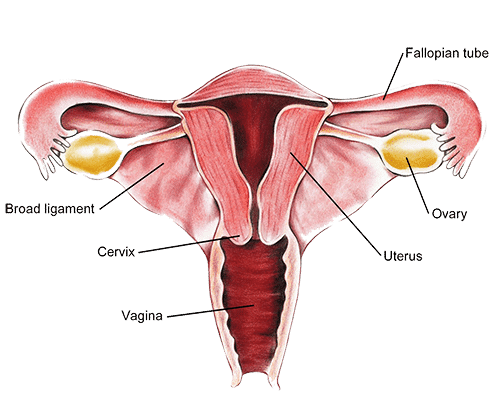The vagina is a canal in female mammals that receives sperm during sex and is part of birthing. It is also the way we dispose of unused endometrium (your period).
A normal vagina is just over the size of an averaged-sized woman’s middle finger, about 9cm or 3.5 inches. It is located between the bladder and the rectum.1
The top part of your vagina connects to the cervix (the lower section of your uterus), with the vaginal canal narrowing at both the top and bottom ends. Until you put something into your vagina that is big enough, you usually still have a small internal fold of tissue also known as the hymen.2
The entrance to the vagina is partially covered with the labia majora.3

What’s inside the vagina
The muscles of the vagina are thick and elastic to facilitate both a penis (or sex toy or fingers or whatever) and pushing a baby out during birth. The muscular wall has two layers of muscle fibres: a weak internal circular layer, and a strong, external lengthways layer.4
Over top of the muscle tissue is a sheath of connective tissue containing lymphatic ducts, blood vessels and nerve fibres. This connective tissue holds you all together, joining the bladder, rectum and pelvis.
The lining of the vagina reacts to hormones with the shedding of old cells, or the building of new cells. The thickness of the lining is directly related to how much oestrogen is available, with the lining thick and elastic around ovulation and pregnancy.
There are transverse ridges called ‘rugae’ which allow the vaginal cavity to stretch, however these become less pronounced or absent in older women and those who have given birth.5

Vagina’s work on lubrication
The vaginal wall produces lubrication during sexual arousal, and there are also glands (Bartholin’s) in the labia that produce moisture in response to sexual stimulation.6
The cervix also produces fluids that come out of the vagina, particularly during ovulation. This is what is commonly referred to as fertile cervical fluid or discharge, which is the vagina maintaining itself.7
Microorganisms in your vagina
Normal vaginal microflora consists of lactic acid and hydrogen peroxide-producing bacteria, dependent on ethnicity. All women, except black women, have high levels of lactobacilli in their vaginas, with black women having less lactobacilli, but more of other kinds of lactic acid-producing bacteria.8
These bacteria keep the vagina safe from invaders using acidity levels, hydrogen peroxide and other defensive weapons. If this balance is disturbed somehow, vaginal conditions such as yeast infections and BV can occur.
For more diagrams, see Vag Basics.
References
- 1.Zdilla MJ. What is a vulva? Anat Sci Int. Published online June 15, 2022:323-346. doi:10.1007/s12565-022-00674-7
- 2.Fahmy MAB. Hymen. Rare Congenital Genitourinary Anomalies. Published online September 20, 2014:159-170. doi:10.1007/978-3-662-43680-6_10
- 3.Graziottin A, Gambini D. Anatomy and physiology of genital organs – women. Handbook of Clinical Neurology. Published online 2015:39-60. doi:10.1016/b978-0-444-63247-0.00004-3
- 4.Sasaki H, Hinata N, Kurokawa T, Murakami G. Supportive tissues of the vagina with special reference to a fibrous skeleton in the perineum: A review. OJOG. Published online 2014:144-157. doi:10.4236/ojog.2014.43025
- 5.Huntington A, Donaldson K, De Vita R. Contractile Properties of Vaginal Tissue. Journal of Biomechanical Engineering. Published online July 6, 2020. doi:10.1115/1.4046712
- 6.Lee MY, Dalpiaz A, Schwamb R, Miao Y, Waltzer W, Khan A. Clinical Pathology of Bartholin’s Glands: A Review of the Literature. Current Urology. Published online May 2015:22-25. doi:10.1159/000365683
- 7.Gutzeit O, Gulati A, Izadifar Z, et al. Cervical mucus in linked human Cervix and Vagina Chips modulates vaginal dysbiosis. npj Womens Health. Published online January 29, 2025. doi:10.1038/s44294-025-00054-2
- 8.Fettweis JM, Brooks JP, Serrano MG, et al. Differences in vaginal microbiome in African American women versus women of European ancestry. Microbiology. Published online October 1, 2014:2272-2282. doi:10.1099/mic.0.081034-0




